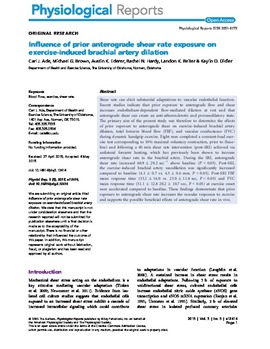| dc.contributor.author | Ade, Carl J. | |
| dc.contributor.author | Brown, Michael G. | |
| dc.contributor.author | Ederer, Austin K. | |
| dc.contributor.author | Hardy, Rachel N. | |
| dc.contributor.author | Reiter, Landon K. | |
| dc.contributor.author | Didler, Kaylin D. | |
| dc.date.accessioned | 2015-06-03T21:24:01Z | |
| dc.date.accessioned | 2016-03-30T15:34:31Z | |
| dc.date.available | 2015-06-03T21:24:01Z | |
| dc.date.available | 2016-03-30T15:34:31Z | |
| dc.date.issued | 2015-05-25 | |
| dc.identifier.citation | Save citation to: Share on citeulikeCiteULike Share on mendeleyMendeley Copy/Download citation: Citation type Provider: John Wiley & Sons, Ltd Content:text/plain; charset="UTF-8" TY - JOUR AU - Ade, Carl J. AU - Brown, Michael G. AU - Ederer, Austin K. AU - Hardy, Rachel N. AU - Reiter, Landon K. AU - Didier, Kaylin D. C7 - e12414 TI - Influence of prior anterograde shear rate exposure on exercise-induced brachial artery dilation JO - Physiological Reports JA - Physiol Rep VL - 3 IS - 5 SN - 2051-817X UR - http://dx.doi.org/10.14814/phy2.12414 DO - 10.14814/phy2.12414 SP - n/a EP - n/a KW - Blood Flow KW - exercise KW - shear rate PY - 2015 ER - Copy and paste citation from the text box or How to cite C. J. Ade, M. Brown, A. K. Ederer, R. Hardy, L. K. Reiter, K. D. Didier. Influence of prior anterograde shear rate exposure on exercise-induced brachial artery dilation. Physiol Rep, 3 (5), 2015, e12414. | en_US |
| dc.identifier.uri | https://hdl.handle.net/11244/14666 | |
| dc.description.abstract | Shear rate can elicit substantial adaptations to vascular endothelial function. Recent studies indicate that prior exposure to anterograde flow and shear increases endothelium-dependent flow-mediated dilation at rest and that anterograde shear can create an anti-atherosclerotic and provasodilatory state. The primary aim of the present study was therefore to determine the effects of prior exposure to anterograde shear on exercise-induced brachial artery dilation, total forearm blood flow (FBF), and vascular conductance (FVC) during dynamic handgrip exercise. Eight men completed a constant-load exercise test corresponding to 10% maximal voluntary contraction, prior to (baseline) and following a 40 min shear rate intervention (post-SRI) achieved via unilateral forearm heating, which has previously been shown to increase anterograde shear rate in the brachial artery. During the SRI, anterograde shear rate increased 60.9 ± 29.2 sec−1 above baseline (P < 0.05). Post-SRI, the exercise-induced brachial artery vasodilation was significantly increased compared to baseline (4.1 ± 0.7 vs. 4.3 ± 0.6 mm, P < 0.05). Post-SRI FBF mean response time (33.2 ± 16.0 vs. 23.0 ± 11.8 sec, P < 0.05) and FVC mean response time (31.1 ± 12.8 20.2 ± 10.7 sec, P < 0.05) at exercise onset were accelerated compared to baseline. These findings demonstrate that prior exposure to anterograde shear rate increases the vascular responses to exercise and supports the possible beneficial effects of anterograde shear rate in vivo. | en_US |
| dc.language | en_US | en_US |
| dc.relation.uri | http://physreports.physiology.org/content/3/5/e12414.most-read | |
| dc.subject | Blood Flow; exercise; shear rate | en_US |
| dc.title | Influence of prior anterograde shear rate exposure on exercise-induced brachial artery dilation | en_US |
| dc.type | Article | en_US |
| dc.description.peerreview | Yes | en_US |
| dc.identifier.doi | 10.14814/phy2.12414 | en_US |
| ou.group | College of Arts and Sciences::Department of Health and Exercise Science | en_US |
